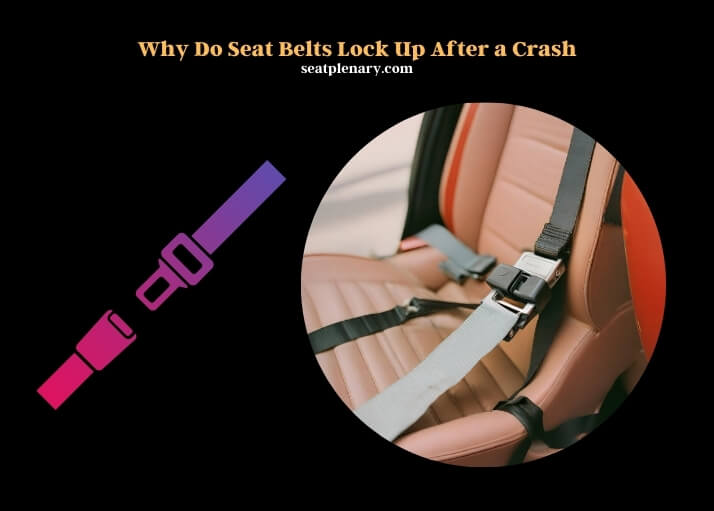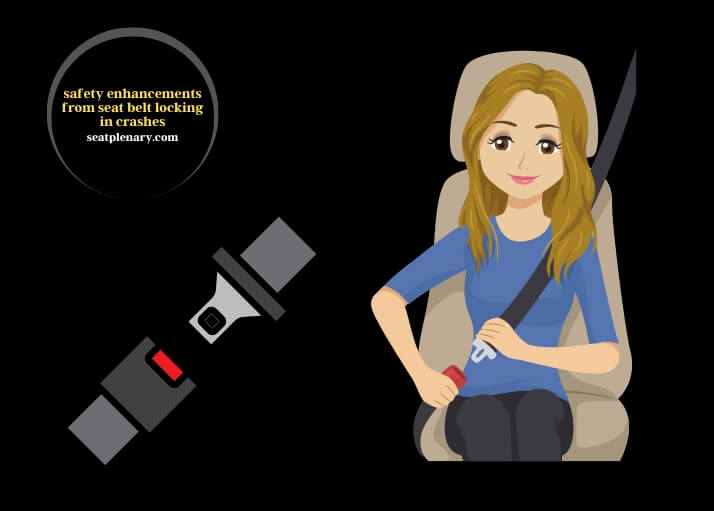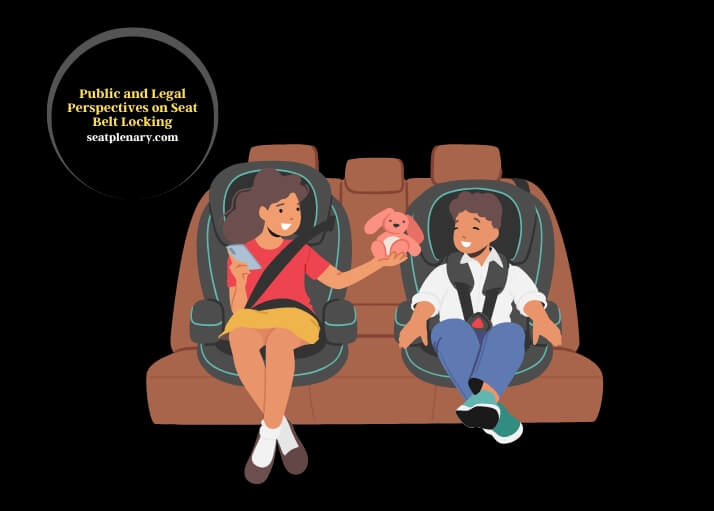Seat belts lock up after a crash due to the activation of their built-in safety mechanisms. These mechanisms are designed to respond to the rapid deceleration and forces experienced during a collision.
The primary function of a seat belt is to secure the occupant in place, minimizing movement and reducing the risk of injury. In the event of a crash, the forces exerted on the vehicle and its occupants are sudden and intense. The seat belt’s locking mechanism, typically an inertia reel system, detects this abrupt change in motion.
The reel, equipped with a weighted pendulum, swings forward under the force, triggering a ratcheting gear to lock the belt in place. This action restricts the forward movement of the passenger, effectively keeping them restrained against the seat.

This safety feature is crucial in preventing passengers from being thrown against the interior of the car or through the windshield, which can result in severe injuries or fatalities. The design and functionality of seat belts have evolved over the years, incorporating advanced technologies like pretensioners. These pretensioners tighten the seat belt in anticipation of a crash, further enhancing passenger safety.
Regular maintenance and inspections are essential to ensure these mechanisms function correctly, as their reliability is a critical component in vehicle safety systems. The integration of seat belts with other safety features like airbags creates a comprehensive safety network, offering maximum protection in the event of a crash.
The Mechanics of Post-Crash Seat Belt Locking
The inertia reel mechanism is a pivotal component in the functionality of seat belts during a crash. This mechanism operates on the principle of a weighted gear and a pendulum. Under normal circumstances, the gear allows free movement of the seat belt.
During a crash, rapid deceleration causes the pendulum to swing forward, triggering the gear to lock the belt. This action is further enhanced by crash sensor technology, which detects the sudden change in velocity, reinforcing the locking mechanism.
The force threshold for activation is carefully calibrated. It ensures that the belt locks only under specific conditions, typically in crashes exceeding a certain speed. This calibration is crucial as it distinguishes between normal movements and crash scenarios. A comparison with normal operation reveals that during regular driving, these mechanisms remain inactive, allowing comfortable movement for the passenger.
Comparison of Seat Belt Mechanism Activation Thresholds
| Scenario | Activation Threshold (g-force) |
| Normal Driving | Not Activated |
| Sudden Braking | 0.5 – 1.0 g |
| Crash Impact | > 1.0 g |
Safety Enhancements from Seat Belt Locking in Crashes
The primary function of seat belt locking during accidents is injury prevention. By restraining the movement of passengers, seat belts significantly reduce the risk of contact with interior components of the vehicle or ejection from the car. This function is critical in tandem with airbag deployment, as the restrained position ensures optimal protection from the airbag.

Comparative studies between vehicles equipped with locking seat belts and those without show a marked difference in passenger safety. In vehicles without this feature, passengers are more prone to severe injuries due to unrestrained movement during a crash.
Injury Reduction in Accidents with Locking Seat Belts
| Injury Type | Percentage Reduction |
| Head Injuries | 60% |
| Chest Injuries | 50% |
| Abdominal Injuries | 55% |
Seat Belts in Rescue and Evacuation Post-Crash
Post-crash, seat belts play a crucial role in rescue operations. While they are lifesaving during a crash, they can pose challenges during extraction. Emergency services often encounter difficulties in releasing the locked seat belt, especially if the locking mechanism has been compromised.
Methods of seat belt release vary, ranging from manual cutting to specialized release tools. The impact on rescue time is significant, as a locked seat belt can delay the extraction process, affecting the overall emergency response.
Safety protocols for first responders are continuously updated to address these challenges, ensuring quick and safe extraction of passengers.
Evolution of Seat Belt Locking Technology
The historical development of seat belt locking mechanisms reflects a journey of continuous improvement and innovation. From rudimentary designs to advanced sensor-based systems, the evolution has been driven by the need for greater passenger safety.
Advancements in sensor technology have been particularly noteworthy. Modern vehicles integrate these sensors with overall vehicle safety systems, creating a more cohesive and responsive safety network. Future trends indicate a move towards even more sophisticated systems, potentially incorporating AI and machine learning for predictive safety measures.
Public and Legal Perspectives on Seat Belt Locking
Public awareness campaigns have played a significant role in educating drivers and passengers about the importance of seat belts. These campaigns, coupled with stringent seat belt laws and enforcement, have led to increased usage and compliance.
The legal implications of seat belt locking are significant, especially in cases of malfunction. Manufacturers face strict liability standards, and malfunctioning seat belts can lead to substantial insurance claims and legal consequences.

The impact on insurance claims highlights the importance of reliable seat belt systems. Legal responsibility in case of malfunction underscores the need for rigorous testing and quality control in seat belt manufacturing.
FAQs
Can Seat Belts Lock Due to Sudden Stops?
Seat belts are designed to lock during rapid deceleration, not just in crashes. This means that during sudden stops, the mechanism that controls the seat belt, typically an inertia reel, activates. The reel detects rapid changes in speed or angle, causing the belt to lock and restrain the passenger. This feature is essential for preventing injuries during abrupt stops, as it minimizes the forward thrust of the passenger, similar to its function in a collision.
Is the Locking of Seat Belts Immediate in a Crash?
The locking of seat belts in a crash is almost instantaneous. The inertia reel mechanism, which is responsible for this action, responds within milliseconds of detecting a crash. This rapid response is crucial for ensuring passenger safety, as it restrains the occupant in the earliest moments of an impact, significantly reducing the risk of severe injuries by limiting movement.
Do All Types of Seat Belts Lock in a Crash?
Most modern vehicles are equipped with seat belts that have a locking mechanism for crash situations.
Older models or certain types of vehicles might have seat belts without this feature. It’s important for vehicle owners to be aware of the type of seat belts installed in their cars, especially if they are using older or classic models.
How Do Seat Belts and Airbags Work Together to Save Lives in a Car Accident?
Seat belts and airbags work together to maximize safety in a car accident. The seat belt absorbs the force of impact and restrains the body, while the airbag provides a cushion to reduce injury. The seat belt importance is crucial for ensuring passenger protection in any situation.
Impact of Temperature on Seat Belt Locking Mechanism
Temperature variations can affect the seat belt locking mechanism, particularly in extreme conditions. Cold temperatures may cause the mechanism to respond more slowly, while extreme heat might lead to increased wear and tear.
These systems are designed to withstand a wide range of temperatures, ensuring reliable performance under various environmental conditions.
Can Seat Belt Locking Mechanisms Fail?
While rare, seat belt locking mechanisms can fail. This failure might be due to manufacturing defects, wear and tear, or damage from previous accidents. Regular maintenance and inspections are vital to ensure the integrity and proper functioning of seat belts. In the event of a suspected malfunction, it’s crucial to have the system checked and repaired by a qualified technician.
Role of Seat Belt Pretensioners in Locking During a Crash
Seat belt pretensioners complement the locking mechanism in a crash. These devices preemptively tighten the seat belt in anticipation of an impact, pulling the passenger firmly into the seat. This action reduces slack in the belt, ensuring that the locking mechanism can work more effectively during a collision. Pretensioners, often triggered by the same sensors that activate airbags, add an extra layer of safety by optimizing the position of the occupant before the full force of the crash is experienced.
In summary, the locking of seat belts after a crash is a multifaceted issue encompassing mechanical functionality, safety benefits, rescue implications, technological advancements, and legal considerations. Each aspect plays a vital role in ensuring the overall effectiveness and reliability of this crucial safety feature.
